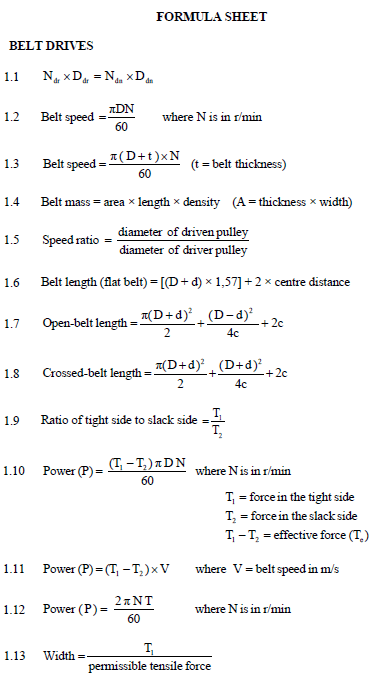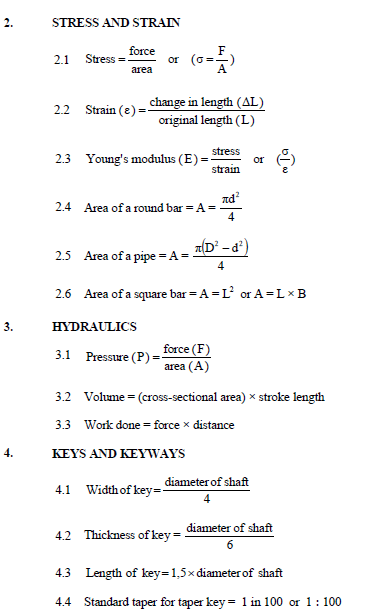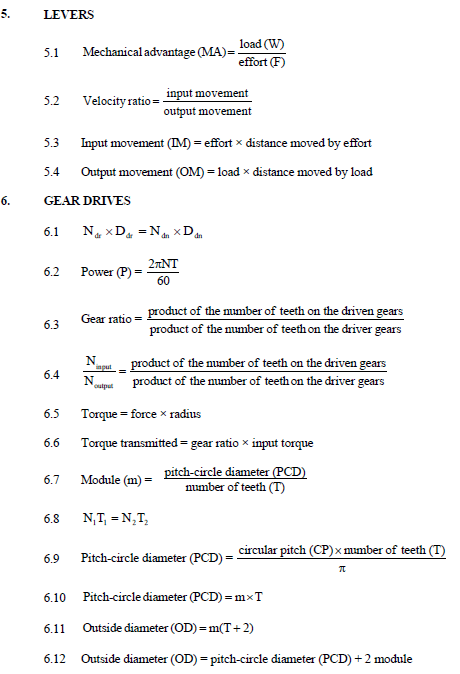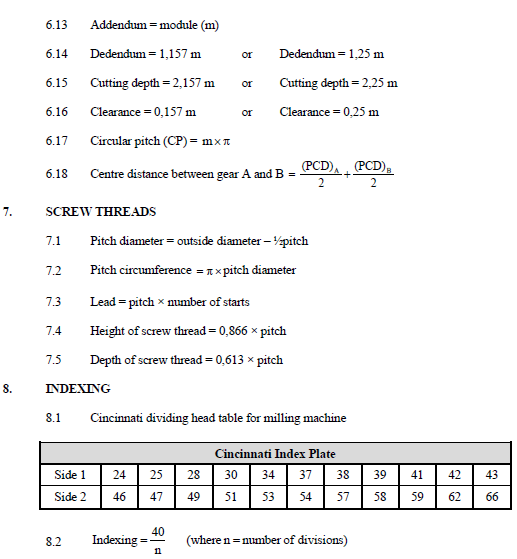MECHANICAL TECHNOLOGY GRADE 12 QUESTIONS - NSC PAST PAPERS AND MEMOS NOVEMBER 2016
Share via Whatsapp Join our WhatsApp Group Join our Telegram GroupMECHANICAL TECHNOLOGY
GRADE 12
NATIONAL SENIOR CERTIFICATE
NOVEMBER 2016
INSTRUCTIONS AND INFORMATION
- This question paper consists of TEN questions.
- Write your centre number and examination number in the spaces provided on the ANSWER BOOK.
- Read ALL the questions carefully.
- Answer ALL the questions.
- Number the answers correctly according to the numbering system used in this question paper.
- Start EACH question on a NEW page.
- Show ALL calculations and units. Round off ALL answers to TWO decimal places.
- Candidates may use non-programmable, scientific calculators and drawing instruments.
- Take the value of gravitational force as 10 m/s-2.
- All dimensions are in millimetres, unless stated otherwise in the question.
- A formula sheet for your use is attached to this question paper.
- Write neatly and legibly.
- Use the guidelines below to assist you in managing your time.
| QUESTION | CONTENT | MARKS | TIME (minutes) |
| 1 | Multiple-choice questions | 20 | 15 |
| 2 | Safety | 10 | 10 |
| 3 | Tools and Equipment | 12 | 10 |
| 4 | Materials | 13 | 10 |
| 5 | Terminology | 30 | 20 |
| 6 | Joining Method s | 25 | 25 |
| 7 | Forces | 30 | 30 |
| 8 | Maintenance | 15 | 15 |
| 9 | Systems and Control | 25 | 25 |
| 10 | Turbines | 20 | 20 |
| TOTAL | 200 | 180 |
QUESTION 1: MULTIPLE-CHOICE QUESTIONS
Various options are provided as possible answers to the following questions. Write down the question number (1.1–1.20), choose the answer and make a cross (X) over the letter (A–D) of your choice in the ANSWER BOOK.
EXAMPLE:![]()
1.21
1.1 What safety measure must be adhered to with regard to the milling machine, according to the Occupational Health and Safety Act, 1993 (Act 85 of 1993)?
- Do not use a wrench on revolving work.
- Remove guards while cutting material.
- Make sure that the wheel is dressed.
- Use the machine table as an anvil. (1)
1.2 What safety measure is applicable to the hydraulic press in terms of the Occupational Health and Safety Act?
- Do not exceed the safe pressure limit.
- Work at a safe speed.
- Lubricate the work piece before mounting it on the press.
- Use the maximum pressure for thicker materials. (1)
1.3 A Brinell tester is used to test the … of a material.
- tension
- elasticity
- hardness
- brittleness (1)
1.4 Which ONE of the following statements describes the function of the tensile tester?
- Determines the length of the material
- Changes the length of the material
- Determines the tensile strength of the material
- Determines the tensile ratio of the material (1)
1.5 A ferrite structure is …
- strong and brittle.
- soft and ductile.
- hard and brittle.
- soft and brittle. (1)
1.6 The lower critical temperature for carbon steel is …
- 100 °C.
- 950 °C.
- 720 °C.
- 610 °C. (1)
1.7 Which milling procedure is shown in FIGURE 1.1?
FIGURE 1.1
- Up-cut milling
- Gear cutting
- Down-cut milling
- Centring of a milling cutter (1)
1.8 What is the included angle of a metric V-screw thread?
- 30°
- 29°
- 60°
- 55° (1)
1.9 Which ONE of the following is a common cause of porosity in a welding joint?
- Dirty or wet electrodes used when arc welding
- Slag not cleaned off the first weld surface before a second weld run
- Faulty restart by not restarting at the top of the previous weld run
- A welding current that is too low (1)
1.10 What is the definition of slag inclusion as a welding defect?
- Metallic solids entrapped in the weld metal
- Gas pores occurring in the solidified weld bead
- Non-metallic solids entrapped in the weld metal
- Melted surface impurities trapped in the weld surface (1)
1.11 What does straight line OA represent in the stress-strain graph shown in FIGURE 1.2?

FIGURE 1.2
- The difference between the stress and strain
- The indirect proportionality between the stress and strain
- The proportionality between the stress and strain
- The similarity between the stress and strain (1)
1.12 What is the class of the lever shown in FIGURE 1.3?
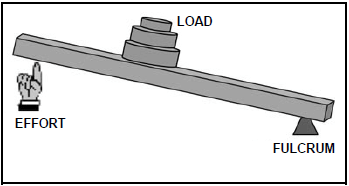
FIGURE 1.3
- 1st class
- 2nd class
- 3rd class
- 4th class (1)
1.13 The law of moments is defined as a system of forces that is in equilibrium if the ...
- coefficient of the clockwise moments around a point is equal to the coefficient of the anticlockwise moments around the same point.
- difference of the clockwise moments around a point is equal to the difference of the anticlockwise moments around the same point.
- sum of the clockwise moments around a point is equal to the sum of the anticlockwise moments around the same point.
- product of the clockwise moments around a point is equal to the product of the anticlockwise moments around the same point. (1)
1.14 Which ONE of the following is an advantage of a chain-drive system?
- Low cost
- No lubrication needed
- Smooth operation
- Slip-free drive (1)
1.15 Which step in adjusting the tension in a chain of a chain drive is shown at point A in FIGURE 1.4?
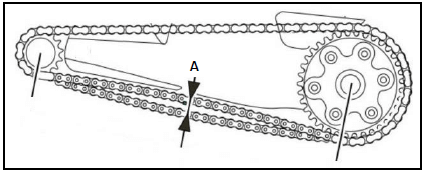
FIGURE 1.4
- Check the distance between the centres.
- Slacken the clamp bolts and screw the adjusting bolt in or out.
- Check the amount of slack in the chain.
- Tighten the clamping bolts. (1)
1.16 FIGURE 1.5 shows a gear train with three gears that mesh. What is gear B called?
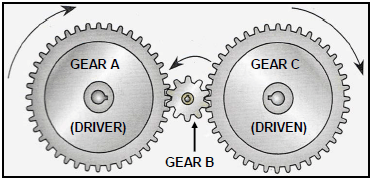
FIGURE 1.5
- Helical gear
- Rack
- Idler gear
- Pinion (1)
1.17 What will the rotation frequency of pulley A be if pulley B is rotating at 1 000 r/min, as shown in FIGURE 1.6?
FIGURE 1.6
- 1 000 r/min
- 2 000 r/min
- 500 r/min
- 100 r/min (1)
1.18 Determine the speed ratio of the chain drive of the racing bicycle shown in FIGURE 1.7.
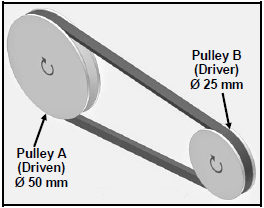
FIGURE 1.7
- 40 : 1
- 1 : 40
- 2,5 : 1
- 1 : 2,5 (1)
1.19 What is the function of the waste gate in a turbo charger? It releases excess …
- pressure.
- moisture.
- heat.
- oil. (1)
1.20 A steam turbine is used to …
- increase the fuel consumption in relation to engine output.
- increase the volumetric efficiency of a four-stroke diesel engine.
- drive a generator to generate electricity.
- decrease the atmospheric pressure of an engine.(1)
[20]
QUESTION 2: SAFETY
2.1 All personal and environmental safety rules were followed when an operator used a surface grinder. State TWO safety rules that should be followed while the surface grinder is in operation. (2)
2.2 Give TWO examples of personal protective equipment that should be used while arc welding. (2)
2.3 State TWO safety rules to be taken into account before applying force to a bearing puller. (2)
2.4 What is the maximum safe distance between the grinding wheel and the tool rest on a bench grinder? (1)
2.5 State THREE safety precautions to be adhered to when a Rockwell hardness tester is used. (3)
[10]
QUESTION 3: TOOLS AND EQUIPMENT
3.1 Give TWO reasons for conducting a bending test on a roof beam. (2)
3.2 Give TWO reasons for a high CO reading when conducting a gas analysis test on the engine of a motor vehicle. (2)
3.3 State TWO advantages of the MIG/MAGS welding process. (2)
3.4 Name TWO tests that can be done with a multimeter. (2)
3.5 Due to engine power loss in a vehicle the mechanic conducts a compression test according to certain procedures. Why are the procedures below followed?
3.5.1 Remove the high-tension lead. (1)
3.5.2 Unplug the fuel-injection system. (1)
3.5.3 Open the throttle valve fully. (1)
3.5.4 Record the readings. (1)
[12]
QUESTION 4: MATERIALS
4.1 State TWO properties of the cementite structure of carbon steel. (2)
4.2 What is the purpose of case hardening on a camshaft? (2)
4.3 What is the purpose of tempering hardened steel? (2)
4.4 Show, by means of a neat drawing, the following elements on an iron-carbon equilibrium diagram:
4.4.1 Carbon content from 0% to 1,4% (1)
4.4.2 Temperature of 0 °C to 1 000 °C (1)
4.4.3 AC1-line (1)
4.4.4 AC3-line (1)
4.4.5 Austenite structure (1)
4.4.6 Ferrite structure (1)
4.4.7 Pearlite structure (1)
[13]
QUESTION 5: TERMINOLOGY
5.1 FIGURE 5.1 shows two spur gears that mesh.

FIGURE 5.1
Use the information above and calculate the:
5.1.1 Module of the small gear (2)
5.1.2 Outside diameter of the big gear (2)
5.1.3 PCD of the big gear (2)
5.1.4 Dedendum of the big gear (2)
5.1.5 Centre distance between the two gears (distance Y) (3)
5.1.6 Required indexing for a gear with 33 teeth (3)
5.2 A taper key must be made to fit onto a 92 mm diameter shaft. Calculate the following:
5.2.1 The width of the key (2)
5.2.2 The length of the key (2)
5.2.3 The thickness of the key at the bigger end (2)
5.2.4 The thickness of the key at the smaller end (4)
5.3 Explain the functions of the following components on the dividing head used on a milling machine:
5.3.1 Index plate (2)
5.3.2 Sector arms (2)
5.4 State TWO methods that may be used on a centre lathe to cut external V-screw threads with a single-point screw-cutting tool. (2)
[30]
QUESTION 6: JOINING METHODS
6.1 State TWO causes of EACH of the following welding defects:
6.1.1 Undercutting (2)
6.1.2 Lack of fusion (2)
6.2 Explain how the ultrasonic test is conducted on a welding joint. (6)
6.3 State ONE advantage of conducting an ultrasonic test rather than an X-ray test on a welding joint. (1)
6.4 An X-ray test is conducted on a welded joint. How are the results observed and recorded? (2)
6.5 Explain the purpose of the dye penetration test on a welding joint. (2)
6.6 Give TWO examples of destructive tests that are conducted on welded joints. (2)
6.7 Name TWO gases used with MIG/MAGS welding. (2)
6.8 FIGURE 6.1 shows the MIG/MAGS welding process. Label A–F.
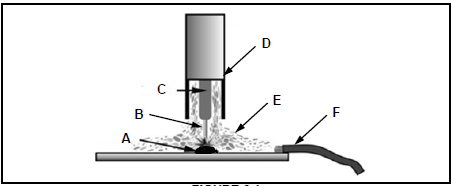
FIGURE 6.1
(6)
[25]
QUESTION 7: FORCES
7.1 Four pulling forces of 100 N, 200 N, 300 N and 185 N are acting from the same acting point, as shown in FIGURE 7.1. Determine, by means of calculations, the magnitude and direction of the resultant of the system of forces in FIGURE 7.1. (13)
(13)
FIGURE 7.1
7.2 A load of 40 kN causes a tensile stress of 20 MPa in a round brass bar. The original length of the bar is 300 mm. Young's modulus for brass is 90 GPa.
Calculate the:
7.2.1 Diameter of the bar (5)
7.2.2 Strain (3)
7.2.3 Change in length (3)
7.3 FIGURE 7.2 shows a uniform beam that is supported by two vertical supports, A and B. A uniformly distributed force of 80 N/m is exerted over the whole length of the beam. Determine, by means of calculations, the magnitudes of the reactions in supports A and B.
 (6)
(6)
FIGURE 7.2
[30]
QUESTION 8: MAINTENANCE
8.1 Name THREE effects of a lack of routine maintenance. (3)
8.2 Name TWO subgroups of preventative maintenance. (2)
8.3 Define the following properties of oils:
8.3.1 Pour point (2)
8.3.2 Flashpoint (2)
8.4 Why are belts on belt drives adjusted or replaced regularly? (2)
8.5 Why is cutting fluid used on the cutting tool during the machining processes on a centre lathe? (2)
8.6 How are chain drives maintained? (2)
[15]
QUESTION 9: SYSTEMS AND CONTROL
9.1 FIGURE 9.1 shows a belt-drive system with a 230 mm driver pulley. The belt speed in this system is 36 m.s-1. The tensile force in the slack side is 140 N and the ratio between the force in the tight side and the force in the slack side is 2,5.

FIGURE 9.1
Calculate the:
9.1.1 Rotation frequency of the driver pulley in r/min (4)
9.1.2 Power transmitted in this system (4)
9.2 FIGURE 9.2 shows a gear-drive system. Driver gear A on the shaft of the electric motor has 18 teeth that mesh with gear B with 36 teeth on a counter shaft. On the counter shaft is a second driver gear, C, with 16 teeth that mesh with gear D with 46 teeth on a second counter shaft. The second counter shaft has a third driver gear, E, with 40 teeth, which drives gear F with 60 teeth on the output shaft.

FIGURE 9.2
Calculate the:
9.2.1 Rotation frequency of the input shaft on the electric motor if the output shaft needs to rotate at 160 r/min (3)
9.2.2 Velocity ratio between the input shaft and output shaft (2)
9.3 A hydraulic system is used to lift a lathe. The specifications of the system are presented diagrammatically in FIGURE 9.3.
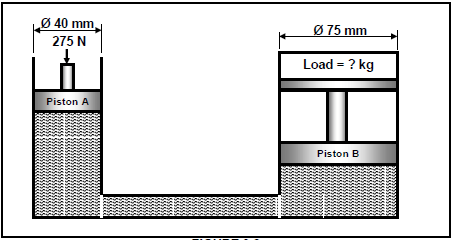
FIGURE 9.3
Calculate the:
9.3.1 Fluid pressure in the hydraulic system when in equilibrium (4)
9.3.2 Load in kilogram that can be lifted by piston B if a force of 275 N is exerted upon piston A (4)
9.4 What is the purpose of traction control in a vehicle? (2)
9.5 Airbags in a vehicle are described as a passive safety feature. Explain the meaning of the term passive safety feature.
(2)
[25]
QUESTION 10: TURBINES
10.1 Name TWO types of blowers that are used as superchargers in the engine of a motor vehicle. (2)
10.2 State the main function of superchargers. (2)
10.3 State TWO advantages of a supercharger when compared to a turbocharger. (2)
10.4 How is a turbocharger driven? (1)
10.5 Define the run-away speed of a water turbine. (2)
10.6 State the operational principles of EACH of the three water turbines shown in FIGURES 10.1, 10.2 and 10.3.
10.6.1  FIGURE 10.1 (2)
FIGURE 10.1 (2)
10.6.2  FIGURE 10.2 (2)
FIGURE 10.2 (2)
10.6.3  FIGURE 10.3 (2)
FIGURE 10.3 (2)
10.7 A gas turbine that is used as a jet engine is shown in FIGURE 10.4. Label phases A to D and part E. (5)
(5)
FIGURE 10.4
[20]
TOTAL: 200
